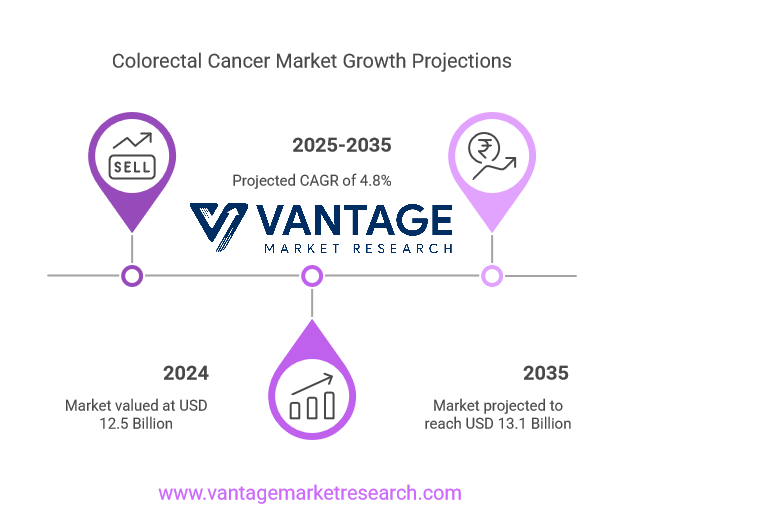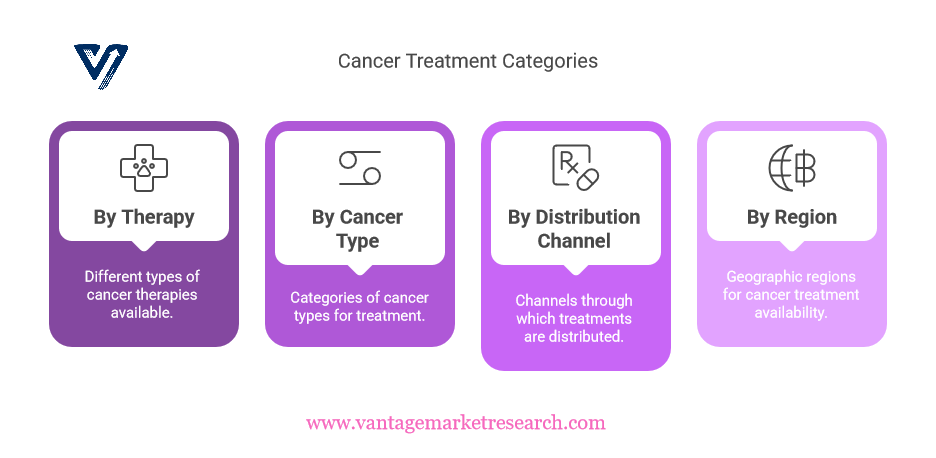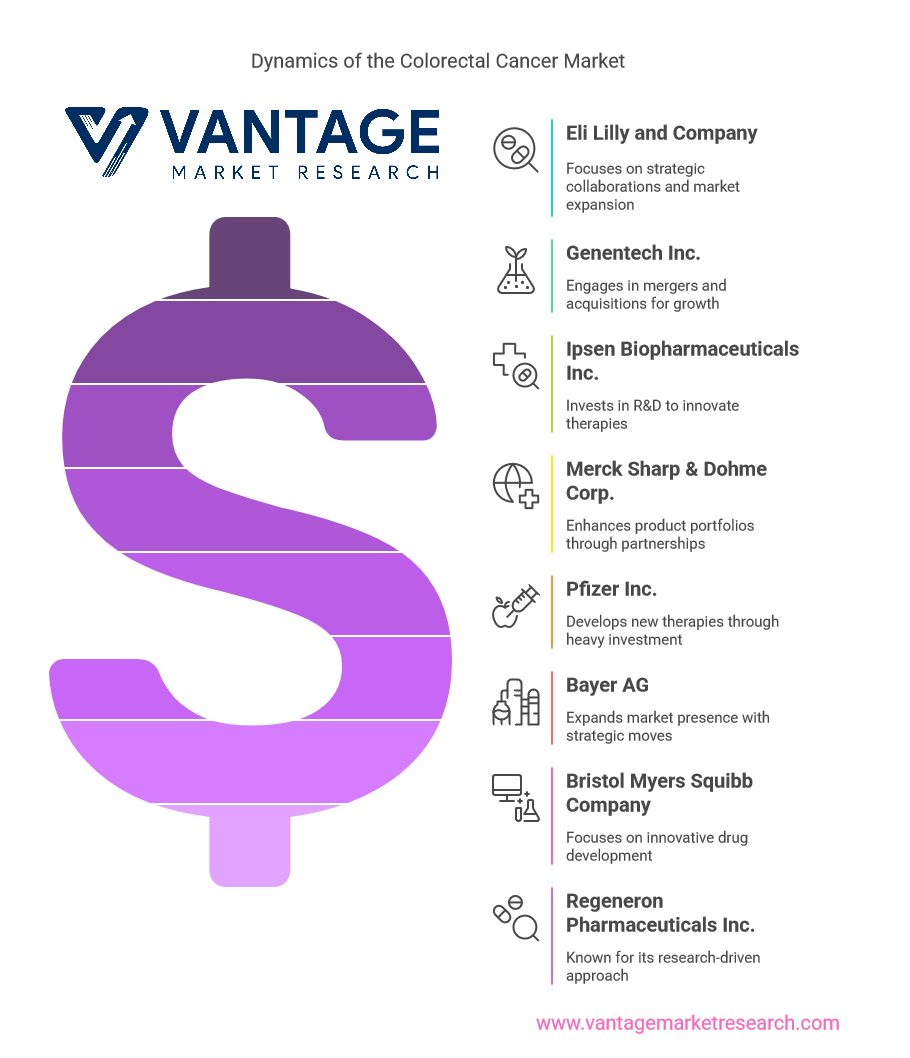Colorectal Cancer Market Forecast 2025-2035 | Trends, Growth, & Competitive Analysis
This comprehensive report analyzes the colorectal cancer market from 2025 to 2035, covering key drivers, challenges, emerging trends, therapy types (including chemotherapy, immunotherapy, and targeted therapy), regional insights, and a competitive landscape of major players such as Eli Lilly, Merck, and Pfizer.

This report offers a comprehensive analysis of the colorectal cancer market from 2025 to 2035, highlighting key trends, market dynamics, and the competitive landscape. With colorectal cancer being one of the leading causes of cancer-related deaths globally, understanding the market's evolution is crucial for stakeholders. The report examines market segmentation, growth drivers, challenges, and emerging opportunities, providing valuable insights that can inform strategic decisions in this crucial healthcare sector.
Colorectal Cancer Market Size and Forecast
Colorectal cancer (CRC) is a major public health concern, characterized by the uncontrolled growth of cells in the colon or rectum. As one of the most prevalent cancers worldwide, its incidence is on the rise, necessitating a thorough understanding of the market dynamics surrounding its treatment and management. This report provides an in-depth analysis of the colorectal cancer market from 2025 to 2035, highlighting key findings, market trends, and the overall significance of the report.
The Colorectal Cancer Market is expected to witness substantial growth over the next decade, driven by factors such as increasing awareness, advancements in treatment modalities, and a growing aging population. The report highlights the importance of targeted therapies and immunotherapies, which are gaining traction due to their effectiveness and lower side effects compared to traditional chemotherapy. Furthermore, the report examines the impact of technological advancements in diagnostics and treatment, which are anticipated to revolutionize patient care in the years to come.
According to analysts at Vantage Market Research, the global Colorectal Cancer Market is valued at USD 12.5 billion in 2024 and is projected to reach a value of USD 13.1 billion by 2035, growing at a compound annual growth rate (CAGR) of 4.8% between 2025 and 2035.
Download Sample Report PDF (Including Full TOC, Table & Figures) @ https://www.vantagemarketresearch.com/colorectal-cancer-market-2502/request-sample

Market Dynamics
Growth Drivers
Several factors, including the increasing prevalence of the disease, advancements in treatment options, and rising awareness about early detection and screening, primarily drive the colorectal cancer market. The aging population is particularly susceptible to colorectal cancer, leading to a higher demand for effective treatment solutions. Additionally, the growing emphasis on personalized medicine and targeted therapies is expected to propel market growth.
Market Restraints & Challenges
Despite the positive growth outlook, the colorectal cancer market faces several challenges. High treatment costs, particularly for advanced therapies, can limit patient access and adherence to treatment. Moreover, the side effects associated with traditional chemotherapy can deter patients from seeking treatment. Regulatory hurdles and the lengthy approval process for new therapies also pose significant challenges for market players.
Growth Opportunities & Emerging Trends
Emerging trends in the colorectal cancer market include the increasing adoption of immunotherapy and targeted therapy, which are showing promising results in clinical trials. The integration of artificial intelligence and machine learning in diagnostics is also expected to enhance early detection rates. Furthermore, the expansion of telemedicine and digital health solutions is likely to improve patient engagement and access to care.
Regional Breakdown
The colorectal cancer market exhibits significant regional variations. North America is currently the largest market, driven by advanced healthcare infrastructure and high awareness levels. Europe follows closely, with increasing investments in research and development. The Asia Pacific region is expected to witness the fastest growth due to rising healthcare expenditures and improved access to treatment options.
Take Action Now: Secure Your Position in the Global Colorectal Cancer Industry Today – Purchase Now.
Segments Insights

The colorectal cancer market can be segmented based on therapy, cancer type, distribution channel, and region.
By Therapy
- Targeted Therapy: This segment is gaining traction due to its effectiveness in treating specific types of cancer with fewer side effects.
- Immunotherapy: Emerging as a promising treatment option, immunotherapy is expected to see significant growth.
- Chemotherapy: Although it remains a mainstay in treatment, its market share may decline as newer therapies gain popularity.
- Other Therapies: This includes various supportive and alternative treatments.
The colorectal cancer market is segmented into chemotherapy, immunotherapy, targeted therapy, and other therapies. Chemotherapy remains one of the most common treatment options, although newer therapies such as immunotherapy and targeted therapy are gaining traction. Immunotherapies, including checkpoint inhibitors, have shown significant promise in the treatment of advanced colorectal cancer, particularly for patients with microsatellite instability-high (MSI-H) tumors. Targeted therapies, such as anti-angiogenesis drugs and epidermal growth factor receptor (EGFR) inhibitors, are also seeing growing adoption due to their ability to specifically target cancerous cells, reducing damage to healthy tissues.
By Cancer Type
- Colorectal Adenocarcinoma: The most common type, accounting for a significant portion of cases.
- Gastrointestinal Carcinoid Tumors: A smaller segment but with unique treatment needs.
- Other Cancer Types: Includes rare forms of colorectal cancer.
The primary types of colorectal cancer include colorectal adenocarcinoma, gastrointestinal carcinoid tumors, and other types. Colorectal adenocarcinoma, the most common form, remains the focal point of therapeutic interventions. Gastrointestinal carcinoid tumors, though less common, require specialized treatment approaches. As the market progresses, personalized medicine and novel therapies are expected to evolve according to the specific type of colorectal cancer.
By Distribution Channel
- Hospital Pharmacies: The primary distribution channel, especially for advanced therapies.
- Retail Pharmacies: A growing channel as patients seek convenience.
- Online Pharmacies: Increasingly popular, particularly since the pandemic.
- Other Distribution Channels: Includes specialty pharmacies and direct-to-consumer models.
The distribution channels in the colorectal cancer market include hospital pharmacies, retail pharmacies, and online pharmacies. Hospital pharmacies remain the primary point of distribution due to their direct access to specialized treatments and oncologists. Retail pharmacies and online pharmacies are emerging as important distribution channels, especially in developed markets, due to their convenience and accessibility.
By Region
- North America: Leading the market due to advanced healthcare systems.
- Europe: Strong growth driven by research and development.
- Asia Pacific: Rapidly expanding market with increasing healthcare access.
- Latin America: Moderate growth with emerging healthcare initiatives.
- Middle East & Africa: Growth potential due to improving healthcare infrastructure.
North America, Europe, and Asia Pacific are the key regions in the colorectal cancer market. North America holds the largest market share, while the Asia Pacific is expected to witness the highest growth rate, driven by the increasing prevalence of colorectal cancer and improvements in healthcare systems. Europe’s market is stable, with a strong focus on research and development.
For the Colorectal Cancer Market Research Report and updates, view the full report now!
Competitive Landscape
The competitive landscape of the colorectal cancer market is characterized by the presence of several key players, including Eli Lilly and Company, Genentech Inc., Ipsen Biopharmaceuticals Inc., Merck Sharp & Dohme Corp., Pfizer Inc., Bayer AG, Bristol Myers Squibb Company, Regeneron Pharmaceuticals Inc., Teva Pharmaceutical Industries Ltd., Taiho Pharmaceutical, Novartis AG, and Sanofi. These companies are focusing on strategic collaborations, mergers, and acquisitions to enhance their market presence and expand their product portfolios. Additionally, they are investing heavily in research and development to innovate and bring new therapies to market.

Strategic collaborations, mergers, acquisitions, and partnerships are prevalent in the competitive landscape as companies seek to diversify their product portfolios, enhance research capabilities, and strengthen their global market position.
Report Coverage
This report offers a comprehensive analysis of the colorectal cancer market, encompassing market dynamics, trends, segmentation, competitive landscape, and regional insights. It highlights key players, their strategies, and the impact of emerging technologies on the market. This report also offers a 10-year forecast from 2025 to 2035, giving stakeholders a comprehensive view of the market’s future trajectory.
This report offers a comprehensive analysis of the colorectal cancer market, encompassing market segmentation, key drivers, industry trends, competitive landscape, and growth projections. It also includes case studies and insights from leading market players, providing a comprehensive view of the current state and future outlook of the industry.
Conclusion and Future Outlook
The colorectal cancer market is expected to experience significant growth from 2025 to 2035, driven by advancements in treatment options, an increasing number of cases, and a greater emphasis on early detection and prevention. Personalized medicine, innovative therapies, and increasing healthcare access in emerging markets will play pivotal roles in shaping the market’s future. However, challenges related to treatment affordability, healthcare infrastructure, and drug resistance will require continued attention. The market’s future outlook remains positive, with substantial growth opportunities in emerging markets and the development of cutting-edge therapies that will likely improve patient outcomes.
In conclusion, the colorectal cancer market is poised for significant growth over the next decade, driven by advancements in treatment options and increasing awareness of the disease. While challenges such as high treatment costs and regulatory hurdles persist, emerging trends, including the adoption of immunotherapy and digital health solutions, present new opportunities for market players. The future outlook is optimistic, with continued innovation and a focus on personalized medicine expected to shape the landscape of colorectal cancer treatment. Stakeholders are encouraged to stay informed about market developments and adjust their strategies to capitalize on the evolving opportunities within this critical healthcare sector.
Frequently asked questions (FAQs).
1. What is the colorectal cancer market?
- The colorectal cancer market refers to the industry involved in the development, production, and sale of therapies, diagnostic tools, and treatments for colorectal cancer. This includes chemotherapy, immunotherapy, targeted therapies, and other related medical products and services.
2. What are the main drivers of growth in the colorectal cancer market?
- Key drivers include the increasing global incidence of colorectal cancer, advancements in early detection and diagnostic techniques, innovations in treatment therapies (e.g., immunotherapy and targeted therapies), and an aging population that is more prone to developing cancer.
3. What are the different types of therapies used for colorectal cancer treatment?
- The main therapies for colorectal cancer include chemotherapy, targeted therapy (such as EGFR inhibitors and anti-angiogenesis drugs), immunotherapy (such as checkpoint inhibitors), and other treatments like radiation therapy and surgery.
4. Which regions are expected to see the most growth in the colorectal cancer market?
- North America, Europe, and the Asia-Pacific region are the primary drivers of the market. However, the Asia-Pacific region is expected to see the highest growth rate due to increased cancer awareness, improved healthcare infrastructure, and growing patient populations.
5. What challenges does the colorectal cancer market face?
- The market faces challenges such as high treatment costs, limited access to advanced therapies in emerging markets, issues with drug resistance and cancer recurrence, and the lengthy regulatory approval process for new treatments.
6. What is the role of personalized medicine in the colorectal cancer market?
- Personalized medicine plays a significant role in tailoring treatments to individual patients based on their unique genetic profiles, thereby improving the effectiveness of treatments and reducing side effects. Genetic testing helps identify the most suitable therapies, such as targeted therapies or immunotherapies.
7. How do emerging therapies, such as immunotherapy and targeted therapy, impact the colorectal cancer market?
- Immunotherapy and targeted therapy have transformed the colorectal cancer treatment landscape by offering more effective and less toxic alternatives to traditional chemotherapy. These therapies specifically target cancerous cells or enhance the immune system's ability to combat cancer, leading to improved survival rates and expanded treatment options.
8. What is the market size of the colorectal cancer industry?
- The colorectal cancer market is expected to grow significantly over the next decade, driven by an increasing incidence of the disease, advancements in treatment options, and a growing focus on early diagnosis. The exact market size varies by region, but it is forecasted to reach billions of dollars globally by 2035.
9. Who are the key players in the colorectal cancer market?
- Major players in the colorectal cancer market include pharmaceutical and biotechnology companies like Eli Lilly, Genentech (Roche), Merck & Co., Pfizer, Bayer, Bristol Myers Squibb, and Novartis. These companies are involved in developing and commercializing new therapies for colorectal cancer, as well as expanding their product portfolios.
10. What is the future outlook for the colorectal cancer market?
- The colorectal cancer market is expected to continue evolving with advancements in personalized medicine, emerging therapies, and better diagnostic tools. The future outlook remains positive, with a focus on enhancing patient outcomes, increasing treatment accessibility, and addressing market challenges such as cost and accessibility, particularly in emerging markets.




![Reproductive Hormones and Proteins Tests Market Trends, Size & Forecast [2024–2035]](https://www.marketbusinessinsights.com/uploads/images/202504/image_430x256_67f61aa3326da.webp)







![Dialysis Market Size, Share, Trends | Growth Analysis [2035]](https://www.marketbusinessinsights.com/uploads/images/202502/image_140x98_67b34ae16c42c.webp)





![Reproductive Hormones and Proteins Tests Market Trends, Size & Forecast [2024–2035]](https://www.marketbusinessinsights.com/uploads/images/202504/image_140x98_67f61aa350968.webp)